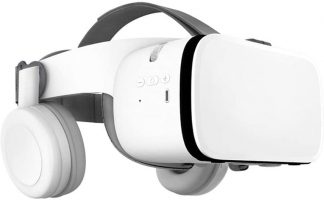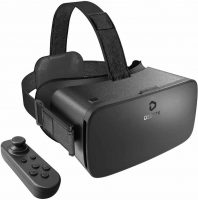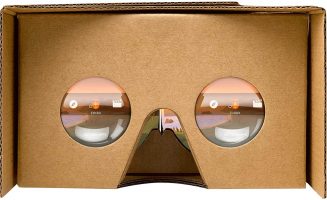Best Cheap VR Headset in 2021
Try out VR on the cheap with the best low-cost VR headsets
- Last Updated Jul 5, 2021

There’s no sidestepping the fact that virtual reality is expensive. With kits like the superb Valve Index priced at just shy of $1000, we still have a way to go before the technology reaches the affordability required for mass adoption. That said, more and more manufacturers are trying their hand at budget-oriented headsets that, while they don’t deliver the same immersive, feature-full experience, give those priced out of premium kits the chance to try out the niche technology.
These are ideal taster kits for those intrigued about what all the fuss is about or who simply want to test the waters before committing to one of the premium options. Unlike more expensive headsets that can cost as much as a mid-range gaming PC and require a decent gaming rig to run, they won’t break the bank and often require no more than a standard smartphone, a device most of us already have.
Today, we’ll be shining a light on some of the best low-cost VR headsets currently available.
Products at a Glance
How We Picked
Our main aim here is to unearth VR headsets that offer a decent VR experience while keeping costs low. We set a price cap of $100 for the simple reason that beyond this threshold we’d veer into territory most would consider expensive.
As most cheap VR headsets don’t include displays, we favored headsets that offer compatibility with various smartphone sizes and brands. We also looked at factors like build quality, comfort, fit and adjustments, included accessories, and, of course, the quality of the VR experience delivered by each headset.
For better or for worse, there’s a growing number of cheap VR headsets out there. Some stretch every dollar to deliver the best experience. Some aren’t worth even their low asking price. To that end, we’ve slimmed down our recommendations to four of the best cheap VR headsets, each a viable option for newcomers eager to try out VR on a budget. Read on to find a brief review of each and a few choice ‘Things to Consider’ pointers at the end.
Best Cheap VR Headset in 2021
Lightweight and comfortable
Distance adjustment
Stereo headphones
Broad phone compatibility
Foldable for easy transport/storage
Price
No controller
For us, the best of the cheap VR headsets is, without a doubt, the Peiloh VR Headset. Not only does it look great with a pleasing white/light grey color scheme, but it has features usually reserved for pricier models, including integrated stereo headphones. These work wirelessly with a smartphone thanks to Bluetooth connectivity and deliver a respectable audio experience, heightening the sense of immersion when gaming or consuming other VR content.
In terms of build quality, the Peiloh VR Headset is a surprisingly solid piece of kit and offers the best comfort levels in the budget range, thanks to reasonably plush breathable padding. The large over-head strap is customizable, and an object adjustment button allows the user to fine-tune focus to suit their needs and find a clear, crisp image. The Peiloh VR Headset also scores points for being lightweight and portable thanks to a fordable design that sees it shrink down for easy storage or transportation.
Additionally, the Peiloh VR Headset is compatible with a broad range of phones such as the iPhone 6/7/8/XR/11/12 and Samsung S8/S9/S10/S20. Setup is incredibly easy with the phone slotting behind a latched front cover that keeps it firmly and securely in place. The phone then pairs with 52 mm high transmittance, anti-blue light lenses, which work well to ease eye fatigue and deliver reasonably detailed visual fidelity.
While cheap when standing shoulder to shoulder with most VR headsets, the Peiloh VR Headset is one of the more expensive low-cost headsets at roughly $75. The extra cost does equate to a better product, though, so in our estimation, the higher price tag is entirely warranted. Another potential issue is that the Peiloh VR Headset lacks a controller. You’ll, therefore, need to either source a third-party controller or limit yourself to control-free VR experiences and navigate between apps via the on-phone touch screen.
Compatible with broad range of phones
Object distance and pupil distance adjustments
Low price
Breathable padding
In the runner-up spot, we have the Misisi VR Headset. Priced at around $30, it’s an incredibly affordable entry point into VR, and while it certainly has its limitations, it should be more than enough for those eager to experiment with VR on a budget.
The Misisi VR Headset scores points for comfort with adjustable straps and object distance/focus adjustment dials that quickly expand or reduce the viewing angle to find the perfect setting for each user. The headset also features a plush PU leather mask that’s both breathable and suitably comfortable. The padding ensures a reasonably comfortable experience even during longer VR sessions. Additionally, the front cover is removable while still keeping the phone firmly in place to aid heat dissipation.
The build construction is decent for the price point and uses high-quality ABS that feels solid enough, although we wouldn’t want to subject the headset to too many drops for fear of it shattering into pieces. Much like the Peiloh above, setup is effortless, with the phone snapping into the front slot with ease. The lenses deliver a decent 108-degree field of view, flirting with what you’d expect from premium headsets from the likes of HTC and Vive.
The Misisi VR Headset is designed to accommodate most non-curved smartphones from leading manufacturers, including the iPhone X, XR, XS, 8, 8 plus, 9, 9 plus, 10, 7, 7 Plus, 6, 6S, 6S Plus, 6 Plus, 6, 5, 5 Plus, 5C, 5S, SE, and Samsung S7, J3, S7 Edge, S6, S6 Edge, Note 5, A8+, Note 3, Note 4, Note 5, Note 7, Note 8, Note 9, S5, S6, S7, S8, S8 Plus, S9, S9 Plus, and S10.
It’s worth noting that the Misisi VR Headset is on the heavy side, so, while generally comfortable, the weight can strain the head and neck over time. Additionally, the headset lacks a controller, which limits using it for interactive VR games.
Includes a controller
110-degree field of view
Soft leather padding and adjustable head strap
Adjustable pupil distance
Controller is no replacement for the real thing
Phone compatibility more limited than other options
For those that want to sample the immersive delights of VR gaming on mobile, the Destek V5 is a strong option that, in keeping with the theme of this guide, is priced incredibly low at just north of $40.
The headline here is the included controller. Paired to both Android and iOS devices via Bluetooth, it features four different modes (player, game, cursor, mouse), one thumbstick, four gamepad-style A/B/X/X buttons, and two menu buttons. Turned horizontally, it can function as a gaming controller suitable for mobile VR titles. It isn’t, of course, comparable to a full-sized controller in both feel and functionality and can be cumbersome to use for those with larger hands. Still, it’s a welcome feature at this price point and one that sets the Destek V5 apart from the competition.
As for the headset itself, it delivers a 110-degree field of view through a pair of sharp aspheric and anti-distortion lenses. A pupil distance adjuster makes easy work of finding the right setting for most users, and the headset is also designed to accommodate glasses.
On the comfort side of things, the mask features soft leather padding, while the rugged leather straps are adjustable, and there’s an anti-leakage silicone seal that sits over the nose to prevent outside light bleeding in. The upper part of the silicone is open to cater to all nose shapes and sizes. The Destek V5 is a little front-heavy, but this is as expected in the low-cost range.
The Destek V5 phone housing is suitable for a decent selection of mobile phones measuring anywhere from 4.7-inches to 6.8-inches. The range is a little less forgiving than the other VR headsets on our list, so double check your phone fits before committing to a purchase. Compatible phones include iPhone 12, 11, X, XR, 6, 6S ,7 , 8, SE, and Samsung S20, S10, Note 10, Note 9, Note 8, A50, A51, and A71.
Extremely low cost
Easy assembly
Phone support
Good quality lenses
No controller
No adjustments
No head strap
No anti-leakage
The Google Cardboard is the cheapest of the cheap VR headsets, making it accessible to anyone with a smartphone and $10 to spare. As the name implies, it’s made of cardboard and is only really designed to sample VR rather than experience the tech as intended as you would with even cheap headsets, not to say premium options like the Valve Index.
The Google Cardboard will happily house both Android and iOS devices sized between 4 and 6-inches and even includes an interactive magnetic button that mimics tapping the phone screen, ideal for on-screen interaction during a VR experience or video. The fruit of Google’s backing, the Cardboard features a surprisingly decent pair of lenses that do well to offer detailed, crisp visuals when paired with a quality phone.
The headset has its own companion app, the Cardboard app, which guides the user through setting up the headset, aligning the phone correctly, and finding interesting VR content to consume. Cleverly, the headset features a chip that will launch the Cardboard app as soon as a phone is fitted into the headset.
While the cardboard construction makes for easy three-step assembly and overall feathery weight, durability does take a massive hit, and you shouldn’t expect the Google Cardboard to last for too long if used regularly. Similarly, the cardboard design means the headset lacks head straps and must instead be held to the eyes, which can be tiring, inconvenient, and detract from the immersive aspect of the experience. It’s fair to say that the Google Cardboard is by far the most uncomfortable headset among our recommendations.
Additionally, by its bare-bones design, the Google Cardboard suffers from light leakage, which degrades the VR viewing experience somewhat. Unsurprisingly, the headset doesn’t ship with a controller or any focus/fit adjustments, either.
Despite these negatives, the Google Cardboard is the perfect way to see what VR is all about for next to nothing and decide whether it’s worth investing in a more expensive, feature-full headset. Go in with the right expectations, and the Google Cardboard can provide hours of fun, especially in educational settings or for children that need entertaining on a rainy afternoon.
Things To Consider
Our Verdict
Among the low-cost VR headsets currently available, we mark the Peiloh VR Headset as one of the best. It’s lightweight, reasonably comfortable, has a decent array of adjustments, stereo headphones, and broad phone compatibility. You won’t get a premium VR experience, it has to be said, but it’s a considerable step up from most other budget VR headsets.
At half the cost of the Peiloh, the Misisi VR Headset is another strong option for those that don’t want to commit a whole $75 to a basic, functional VR headset. Despite a low price, the headset still has some decent features, including plenty of adjustments, decent build quality, and compatibility with some of the most popular phones out there.
While cheap VR headsets limit what type of content you can consume, the Destek V5 goes to lengths to offer a gaming-ready low-cost headset, not least thanks to the included controller, comfortable fit, 110-degree field of view, and fit adjustment. It’s only let down by limited phone compatibility.
Designed as a fun, easy to assemble taste of what VR is all about, the Google Cardboard is a perfect fit for those unwilling to spend more than $10 to test VR but don’t mind a pretty rudimentary setup made, as the name implies, of cardboard. It certainly has its limitations but is a surprisingly value-packed window into the world of VR.
And with that, we’ll bring our guide to the best cheap VR headsets to an end. The comment section is open, so don’t hesitate to send any questions, suggestions, or concerns our way.




